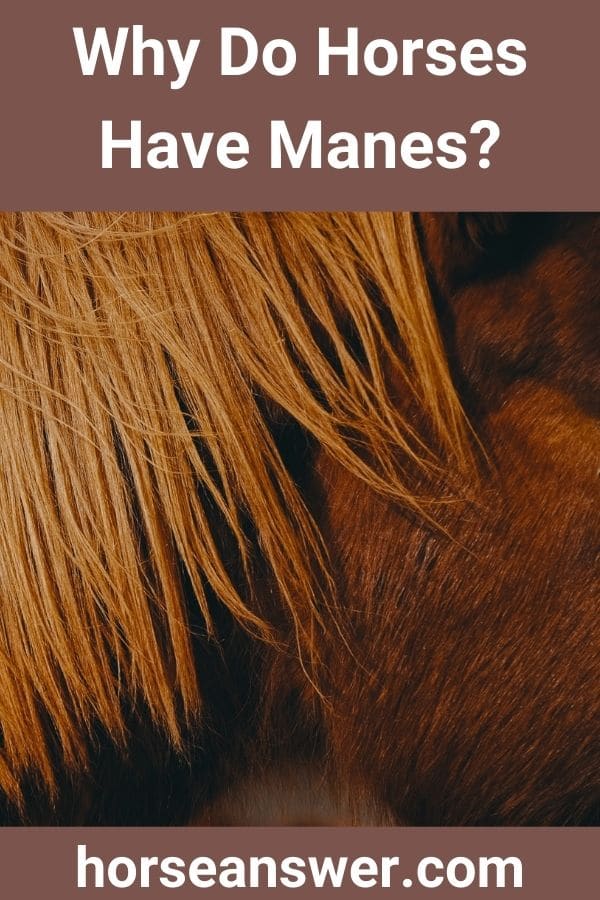Why Do Horses Have Manes? (Revealed!)
Braiding my horse’s mane has always been one of my favorite activities; I love running my fingers through his long brown locks and seeing how many different styles I can achieve.
The other day as I was grooming him, I began thinking about how strange it is that no other animal has a mane quite like a horse.
They are unique, which made me wonder, “why do horses have manes?”
Horses have manes for a variety of reasons, including protection, insulation, and attraction. Manes protect the horse from various risks, insulate them from the cold, and help the horse attract a mate. Manes are beautiful, but taking a closer look can reveal how beneficial they are too.
Have you ever wondered what exactly a mane is and if they all look alike?
What is their purpose?
Are they only for looks?
For the answer to all these questions and more, keep reading!
What Is A Mane?
Before we can answer why horses have manes, it’s important to know what a mane is.
A mane is the hair on a horse’s neck stretching from the top of its head to its withers.
Also included is the forelock, which comes down onto its face and looks like bangs.
A horse’s mane does not have any feeling, and it’s possible to pull it without causing any pain or discomfort.
Like human hair, a horse’s mane can only grow to a certain length, so it’s good to limit how often it is cut and take care not to pull out too many strands.
All horses have manes regardless of the breed.
Do All Manes Look Alike?
No, not all manes look alike; their appearance is a result of the breed.
For example, Appaloosa’s have sparse manes while breeds like Friesians and Andalusians’ manes are long and thick.
Whether or not the horse is wild or domesticated can also affect the way its hair looks.
Wild horses tend to have shorter, thicker manes than their domestic cousins, who have longer, more decorative-looking locks thanks to decades of breeding.
The color varies greatly as well, even within the same breed.
Why Do Horses Have Manes?
Although beautiful, a horse’s mane is also very useful.
There are four mane reasons (pun intended) a horse has a mane.
Protection
Manes offer horses protection from a variety of different threats.
The first is from predators.
In the wild, horses are prey animals for predators who generally go for the neck when killing.
The horse’s thick hair prevents the predator from getting a good grip and can help keep the horse from becoming a meal.
Another way manes offer protection is from flies and other biting insects.
The hair hangs down the horse’s neck and acts as a barrier against any bug trying to land and either bite or sting it.
The forelock protects the horse’s eyes from flies and other insects that could irritate them or cause damage.
It also acts as a shield against dirt and debris and helps shade the sun.
The third way a horse’s mane protects it is by shielding its neck from other horses.
Male horses will fight each other for territory or the right to mate with a female, and the mane helps keep their neck safe from bites and kicks during these fights for dominance.
It isn’t uncommon to see a horse with chunks torn out of its mane during mating season, or if the surrounding territory is shrinking due to human involvement or natural causes, like fires or flooding.
Insulation
Horses adapt to colder climates by developing a thick coat to shield them from dropping temperatures—this same concept applies to their manes.
The thick, dense hair acts like a snowcap for the horse, keeping their warmth and the cold out.
Just like humans, horses lose a large amount of heat from their heads and neck, so by having an extra layer of insulation, they can withstand harsh winters.
Horses in hot climates also benefit from the insulative properties of their manes.
Like a dog’s undercoat works to keep it cool in summer, a horse’s mane helps keep the heat out and the coolness in.
The hair blocks the neck from the sun and helps cool the horse and keep it from over-heating.
Sun Protection
As stated before, manes help block the sun from the horse’s neck, which helps keep it cool in the summertime.
The forelock also works like sunglasses, helping shield the horse’s eyes from direct sunlight and keeping it from looking directly into the sun.
Coupled with their extra-long eyelashes, the forelock provides excellent sun protection for the horse.
Attracting A Mate
Much like Fabio in the late ’80s, male horses with a flowing mane are irresistible to females.
Horses manes attract a female looking to mate and may be highly influential in a female horse’s decision.
Since the appearance of the hair is directly affected by the horse’s health, if it has a thin, ratty-looking mane, a female will most likely not be interested in mating.
However, if its hair is full and long, the female will see it as a sign of good health and strong genes and will be more likely to choose it as a potential partner.
A long full mane also has the added advantage of making the horse look bigger, which is helpful when attracting a mate and avoiding a fight over its territory.
The larger it seems, the less likely another horse will want to try and fight.
Horse manes are unique in the animal world, and no other creature has one just like it.
Whether used as protection, insulation, a barrier from the sun, or in attracting a mate, manes are essential for a horse’s well-being.
Be sure never to cut your horse’s mane too short or leave it braided for excessive amounts of time.
Taking good care of its mane will help ensure it takes good care of your horse, in turn.
